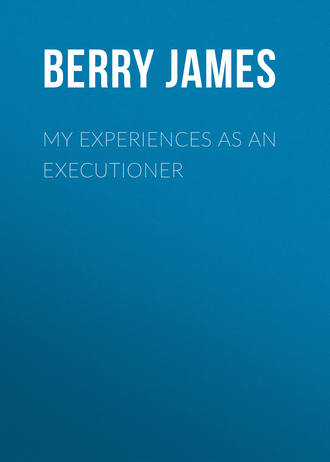 полная версия
полная версияMy Experiences as an Executioner
As this was my first execution, I was naturally anxious to have an assurance from my employers that it had been satisfactorily carried out. The magistrates, the governor, and the surgeons all signified their satisfaction, in the following terms: —
City Chambers, Edinburgh,1st May, 1884We, the Magistrates who were charged with seeing the sentence of death carried into effect, on the 31st March last, on Robert F. Vickers and William Innes, in the Prison of Edinburgh, hereby certify that James Berry, of Bradford, who acted as Executioner, performed his duties in a thoroughly efficient manner; and that his conduct during the time he was here was in every way satisfactory.
George Roberts, Magistrate.Thomas Clark, Magistrate.H.M. Prison, Edinburgh,31 March, 1884I hereby certify that Mr. James Berry, assisted by Mr. Richard Chester, carried out a double Execution in this Prison on this date, and that the whole of his arrangements were gone about in a most satisfactory and skilful manner; and, further, that the conduct of Messrs. Berry and Chester, during the four days that they resided here, has been all that could be desired.
J. E. Christie, Governor of H.M. Prison.Edinburgh, 31st March, 1884.We hereby certify that we have this day witnessed the Execution of Vickers and Innes, and examined their bodies. We are of opinion that the Execution of these men was admirably managed; and that the Executioner Berry and his Assistant conducted themselves in a cool, business-like manner, to our entire satisfaction; death being instantaneous.
James A. Sidey, M.D.,Surgeon to H.M. Prison of Edinburgh.Henry D. Littlejohn, M.D.,Surgeon of Police.I fear it seems like self-praise to publish these “testimonials,” but my work is so often maligned in common conversation, that I feel that it is a duty to give the opinions of a few of the men on the spot, who are most competent to judge of the matter. I believe that in every case where I have conducted an execution, the authorities have been perfectly satisfied, and I could produce numerous letters to that effect, but I will content myself with one, from the prison where I have had the greatest number of executions. It is dated a few years ago, but it would be endorsed now, and such testimony is very gratifying to me.
Strangeways Prison,11th June, 1887During the period Mr. James Berry has been public Executioner he has always given satisfaction at this Prison in carrying out Capital Sentences, and his conduct has been marked by firmness and discretion.
J. H. Purton, Jr.CHAPTER IV
My Method of Execution. CALCULATIONS AND APPARATUS
My method of execution is the outcome of the experience of my predecessors and myself, aided by suggestions from the doctors, and is rather the result of gradual growth than the invention of any one man.
The DropThe matter which requires the greatest attention in connection with an execution is the allowance of a suitable drop for each person executed, and the adjustment of this matter is not nearly so simple as an outsider would imagine.
It is, of course, necessary that the drop should be of sufficient length to cause instantaneous death, that is to say, to cause death by dislocation rather than by strangulation; and on the other hand, the drop must not be so great as to outwardly mutilate the victim. If all murderers who have to be hanged were of precisely the same weight and build it would be very easy to find out the most suitable length of drop, and always to give the same, but as a matter of fact they vary enormously.
In the earliest days of hanging it was the practice for the executioner to place his noose round the victim’s neck, and then to haul upon the other end of the rope, which was passed through a ring on the scaffold pole until the culprit was strangled, without any drop at all. After a while the drop system was introduced, but the length of drop given was never more than three feet, so that death was still generally caused by strangulation, and not by dislocation, as it is at present. One after another, all our English executioners followed the same plan without thought of change or improvement, until Mr. Marwood took the appointment. He, as a humane man, carefully considered the subject, and came to the conclusion that the then existing method, though certain, was not so rapid or painless as it ought to be. In consequence he introduced his long-drop system with a fall of from seven to ten feet, which caused instantaneous death by severance of the spinal cord. I was slightly acquainted with Mr. Marwood before his death, and I had gained some particulars of his method from conversation with him; so that when I undertook my first execution, at Edinburgh, I naturally worked upon his lines. This first commission was to execute Robert Vickers and William Innes, two miners who were condemned to death for the murder of two game-keepers. The respective weights were 10 stone 4 lbs. and 9 stone 6 lbs., and I gave them drops of 8 ft. 6 in. and 10 ft. respectively. In both cases death was instantaneous, and the prison surgeon gave me a testimonial to the effect that the execution was satisfactory in every respect. Upon this experience I based a table of weights and drops. Taking a man of 14 stones as a basis, and giving him a drop of 8 ft., which is what I thought necessary, I calculated that every half-stone lighter weight would require a two inches longer drop, and the full table, as I entered it in my books at the time, stood as follows: —
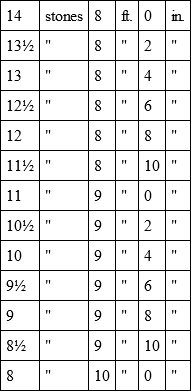
This table I calculated for persons of what I might call “average” build, but it could not by any means be rigidly adhered to with safety. For instance, I have more than once had to execute persons who had attempted suicide by cutting their throats, or who had been otherwise wounded about the neck, and to prevent re-opening the wounds I have reduced the drop by nearly half. Again, in the case of persons of very fleshy build, who often have weak bones and muscles about the neck, I have reduced the drop by a quarter or half of the distance indicated by the table. If I had not done so, no doubt two or three of those whom I have executed would have had their heads entirely jerked off, – which did occur in one case to which I shall again refer. In the case of persons with scrofulous tendencies it is especially necessary that the fall should be unusually short, and in these cases I have at times received useful hints from the gaol doctors.
Until November 30th, 1885, I worked to the scale already given, but on that date I had the awful experience above referred to, which caused me to reconsider the whole subject and to construct a general table on what I believe to be a truly scientific basis. The experience referred to is dealt with in another chapter. The man with whom it occurred was Robert Goodale, whom I executed at Norwich Castle. He weighed 15 stones, and the drop indicated by the first table would therefore be 7 ft. 8 in., but in consequence of his appearance I reduced it to 5 ft. 9 in., because the muscles of his neck did not appear well developed and strong. But even this, as it turned out, was not short enough, and the result was one of the most horrible mishaps that I have ever had. As will be seen from the full report of this case, in another chapter, the coroner exonerated me from all blame and testified to the careful way in which I had done my work; but I felt that it was most necessary to take every possible precaution against the recurrence of such an affair. I, therefore, worked out a table of the striking force of falling bodies of various weights falling through different distances; which table I give on page 34. Working with this, I calculate that an “average” man, of any weight, requires a fall that will finish with a striking force of 24 cwt., and if the convict seems to require less, I mentally estimate the striking force that is necessary, and then by referring to the table I can instantly find the length of drop required. To see how this new table works out we may take the case of Robert Goodale again. As he weighed 15 stones his striking force with a drop of 2 feet would be 21 cwt. 21 lbs., or with a drop of 3 feet 26 cwt. 7 lbs., so that if he were a man of ordinary build the drop necessary would be 2 ft. 6 in. As I estimated from his appearance that his drop ought to have been about one-sixth less than the standard, I should have given him, working on this new table, about 2 ft. 1 in. instead of the 5 ft. 9 in. which was actually given. This is an extreme case, with a very heavy man, but all through the table it will be found that the drop works out shorter than in the first table. For instance, Vickers and Innes, the two Edinburgh murderers previously referred to would have had their drops reduced from 8 ft. 6 in. and 10 ft. to 5 ft. 6 in. and 7 ft. respectively if they had been treated according to the present revised table.
On August 20th, 1891, at Kirkdale Gaol, Liverpool, at the execution of John Conway, an attempt was made to dictate to me the length of drop, and a most unfortunate scene ensued. From seeing the convict, Conway, I had decided that the drop ought to be 4 ft. 6 in., a little under the scale rate; and I was surprised and annoyed at being told by Dr. Barr, acting, I believe, under authority, that I was to give a drop of 6 ft. 9 in. I said that it would pull the man’s head off altogether, and finally refused to go on with the execution if such a long drop were given. Dr. Barr then measured off a shorter drop, some ten or twelve inches shorter, but still much longer than I thought necessary, and I reluctantly agreed to go on. The result, everyone knows. The drop was not so long as to absolutely pull off the victim’s head, but it ruptured the principal blood-vessels of the neck.
SCALE SHOWING THE STRIKING FORCE OF FALLING BODIES AT DIFFERENT DISTANCES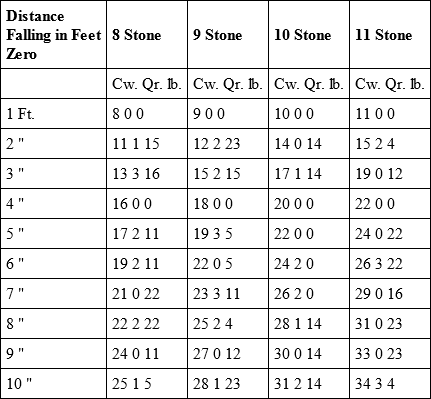
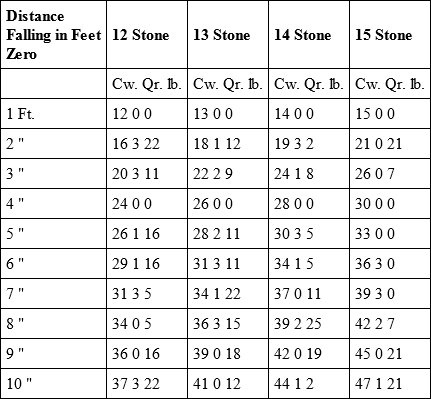
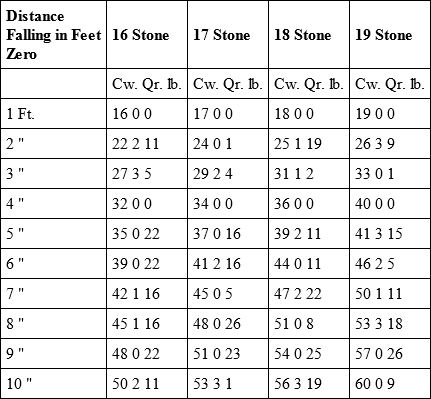
I do not know who was really responsible for the interference with my calculation, but do not think that the long drop was Dr. Barr’s own idea, as the drop which I suggested was on the same system as he had previously commended, and was almost identical with the drop that would have worked out on the basis of his own recommendation in a letter to the Times some years ago. Dr. Barr’s letter to me, written in 1884, was as follows: —
1, St. Domingo Grove,Everton,Liverpool, Sept. 2nd, 1884Sir,
In compliance with your request I have pleasure in giving you a certificate as to the manner in which you conducted the execution of Peter Cassidy in H.M. Prison, Kirkdale. I may now report the statement which I gave in evidence at the Inquest, “that I had never seen an execution more satisfactorily performed.” This was very gratifying to me.
Your rope was of excellent quality; fine, soft, pliable, and strong. You adjusted the ring, directed forwards in the manner in which I have recommended in my pamphlet, “Judicial Hanging.” You gave a sufficient length of drop, considering the weight of the culprit, and completely dislocated the cervical vertebræ between the atlas and axis (first and second vertebræ). I have reckoned that the weight of the criminal, multiplied by the length of the drop, might range from 1120 to 1260 foot pounds, and I have calculated that this vis viva in the case of Cassidy amounted to 1140 foot pounds.
The pinioning and other details were carried out with due decorum, I hope, whoever be appointed to the post of public Executioner, may be prohibited from also performing the part of a “showman” to gratify a depraved and morbid public curiosity.
James Barr, M.D.,Medical Officer, H.M. Prison, KirkdaleTo Mr. James Berry.A few days after Conway’s execution I received a letter from a gentleman in the South of London, shortly followed by a second letter, and as they throw some useful light upon the subject I give them in full – omitting the writer’s name, as he does not wish it to be published.
August 22nd, 1891. Re the Execution at KirkdaleSir,
As the accident attending the execution on the 20th inst. at Kirkdale may be falsely, and very unjustly, charged to your account, and at the same time be brought forward by a mass of misguided people as a reason for the total abolition of capital punishment, I think the following remarks on the subject of hanging may not be out of place.
Some years ago, Dr. James Barr, medical officer at Kirkdale Gaol, published a letter in the Times regarding what he considered the proper length of drop. He said that the length of drop ought to be such as to produce a momentum of 2600 lbs., meaning by “momentum,” the convict’s weight multiplied by the velocity of his descent at the end of the fall. Now, in estimating the convict’s weight, I conceive that you ought to leave out the weight (as far as you can guess it) of his head, because the weight of his head is supported by the noose when the jerk takes place, and, therefore, cannot affect the amount of pull, or strain, on the neck. From what Dr. Barr says regarding the 2600 lbs. momentum, it is easy, by a little mathematics, to deduce the following rule.
To find length of drop in feet, divide the number 412 by the square of the convict’s weight of body in stones.
By the above rule I constructed the following table: —
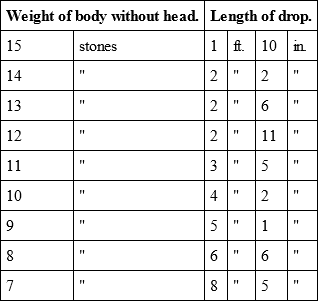
Convict Conway’s weight, you are reported to have said, was 11 stones 2 lbs. Leaving 1 stone for the weight of his head, which is perhaps more than sufficient, his hanging weight would be 10 stones 2 lbs, so that a drop of 4 feet and a few inches2 would have been, according to the doctor’s rule, quite enough for him. Regarding the value of the rule, I am, of course, unable to speak; nor do I know, from what I remember of the doctor’s letter, that he meant the 2600 lbs. momentum to apply in all cases. Much depends on the convict’s build, strength of neck, etc.
Yours truly,X. Y.(Second letter.)August 25th, 1891. Re the Execution at KirkdaleSir,
In constructing the table I sent you two days ago, I find that I have made an absurd mistake. It arose from my carelessly taking a stone weight as 16 lbs., instead of 14 lbs., which I beg you to allow me correct. Instead of the number 412, I ought to have given the number 539. The corrected rule based on Dr. Barr’s momentum of 2600 lbs. is, therefore, as follows: – Length of drop, in feet, is found by dividing the number 539 by the square of the number of stones in weight of convict’s body, exclusive of the weight of his head. Thus, if a convict weighs 11 stones altogether, and we take his head as 1 stone, we have length of drop = 539/100 = 5·39 feet (5 ft. 5 in. nearly).
The table, corrected, stands thus: —
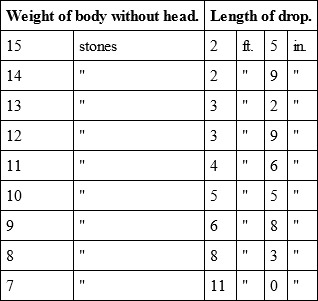
In allowing, in the case of convict Conway, who weighed 11 stones 2 lbs., 1 stone for the head, I may be allowing too much; it is a mere guess. If his head weighed 9 lbs., the drop ought to have been 4 ft. 10 in.
Yours truly,X. Y.P.S. – A mistake of 3 or 4 lbs. in estimating weight of head makes, you will see, a considerable error in calculating the drop.
It will be seen that this calculation, which does not include the weight of the head in a man’s hanging weight, works out the drop to a rather greater length than my own table, but the difference is only small, and I have always found my own table give quite sufficient drop.
The RopeThe apparatus for carrying out the extreme penalty of the law is very simple. The most important item is the rope, which must necessarily possess certain properties if the death of the condemned person is to be instantaneous and painless.
For successful working the rope must, of course, be strong, and it must also be pliable in order to tighten freely. It should be as thin as possible, consistent with strength, in order that the noose may be free running, but of course, it must not be so thin as to be liable to outwardly rupture the blood vessels of the neck.
Before undertaking my first execution I gave careful consideration to the question of the most suitable class of rope, and after trying and examining many varieties, I decided upon one which I still use. It is made of the finest Italian hemp, ¾ of an inch in thickness. Before using a rope for an execution, I thoroughly test it with bags of cement of about the weight of the condemned person, and this preliminary testing stretches the cord and at the same time reduces its diameter to ⅝ of an inch. The rope consists of 5 strands, each of which has a breaking strain of one ton dead weight, so that it would seem unnecessary to test it from any fear of its proving too weak, but the stretching and hardening which it undergoes in the testing makes it far more “fit” and satisfactory for its work than a new, unused rope would be.
It has been said that I use a rope with a wire strand down the centre, but the notion is so ridiculous that I should not refer to it if it were not that many people seem to believe it, and that more than once it has been stated in the newspapers. A rope with a wire strand would possess no possible advantage that I can see, and it would have so many practical disadvantages that I do not think anyone who had studied the matter would dream of using such a thing. At any rate I have not done so, and I know that neither Mr. Binns nor Mr. Marwood ever did. Mr. Marwood used ropes of about the same quality and thickness as my own, while Mr. Binns used a much thicker rope (about 1¼ inch diameter after use), of a rougher and less pliable class of hemp.
Until the commencement of 1890 I supplied my own ropes, some of which, however, were made to order of the Government, and I was able to use the same rope again and again. One I used for no less than sixteen executions, and five others I have used for twelve executions each. These are now in the possession of Madame Tussaud. At the beginning of 1890 a new rule was made under which a new rope is ordered to be supplied and used for most of the executions in England, and to be burned, together with the clothes of the person executed (which were formerly a perquisite of the executioner) by the prison officials immediately after the execution. In Scotland and Ireland I still provide my own ropes.
The rope I use is thirteen feet long and has a one-inch brass ring worked into one end, through which the other end of the rope is passed to form the noose. A leather washer which fits the rope pretty tightly, is used to slip up behind the brass ring, in order to prevent the noose slipping or slackening after it has been adjusted.
In using the rope I always adjust it with the ring just behind the left ear. This position I never alter, though of course, if there were any special reason for doing so, for instance, if the convict had attempted suicide and were wounded on the side of the throat, death could be caused by placing the ring under the chin or even behind the head. The position behind the ear, however, has distinct advantages and is the best calculated to cause instantaneous and painless death, because it acts in three different ways towards the same end. In the first place, it will cause death by strangulation, which was really the only cause of death in the old method of hanging, before the long drop was introduced. Secondly, it dislocates the vertebra, which is now the actual cause of death. And thirdly, if a third factor were necessary, it has a tendency to internally rupture the jugular vein, which in itself is sufficient to cause practically instantaneous death.
Pinioning Straps, EtcThe pinioning arrangement, like the rest of the arrangements for an execution, are very simple. A broad leathern body-belt is clasped round the convict’s waist, and to this the arm-straps are fastened. Two straps, an inch and a half wide, with strong steel buckles, clasp the elbows and fasten them to the body-belt, while another strap of the same strength goes round the wrists, and is fastened into the body-belt in front. The legs are pinioned by means of a single two-inch strap below the knees. The rest of the apparatus consists of a white cap, shaped somewhat like a bag, which pulls down over the eyes of the criminal to prevent his seeing the final preparations.
The ScaffoldUntil recently, the scaffolds in use in the various gaols differed very much in the details of their construction, as there was no official model, but in each case the local authorities followed their own idea. In 1885, however, a design was drawn, in the Surveyors’ Department of the Home Office, by Lieut. – Col. Alten Beamish, R.E. Before being finally adopted, the design was submitted to me; and it seemed a thoroughly good one, as, indeed, it has since proved to be, in actual practice. The design is supplied to the authorities of any gaol where a scaffold is to be erected, from the Engineers’ Department at the Home Office; and, with a slight alteration, has been the pattern in general use to the present day. The alteration of which I speak, is a little one suggested by myself, and consists of the substitution of a slope, or a level gangway, in place of the steps. I had found in some cases, when the criminals were nervous or prostrated, that the steps formed a practical difficulty. The slope, or gangway, was approved by the Home Office, and was first used on April 15th, 1890, at Kirkdale Gaol, for the execution of Wm. Chadwick. It was a simple improvement, but it has turned out to be a very useful one.
At most of the gaols in the country the scaffold is taken to pieces and laid away immediately after use, but in Newgate, Wandsworth, Liverpool, and Strangeways (Manchester), it is kept standing permanently.
The essential parts of the scaffold are few. There is a heavy cross-beam, into which bolts terminating in hooks are usually fastened. In some cases this cross-beam stands on two upright posts, but usually its ends are let into the walls of the scaffold house. Of course, the hooks fastened to it are intended to hold the rope.
The scaffold proper, or trap, or drop, as it is variously called, is the portion of the structure to which most importance is attached, and of which the Government furnishes a plan. It consists of two massive oaken doors, fixed in an oak frame-work on a level with the floor, and over a deep bricked pit. The plan and section will explain the arrangement. The two doors are marked A A and B B on the plan. The door A A is hung on three strong hinges, marked C C C, which are continued under the door B B. When the trap is set the ends of these long hinges rest on a draw-bar E E, as shown in the plan. The draw-bar is of iron, 1¼ in. square, sliding in strong iron staples, F F F, which fit it exactly. When the lever D is pulled over in the direction of the little arrow, it moves the draw-bar in the opposite direction, so that the ends of the long hinges drop through the openings H H H, and the two doors fall. To set the trap the door B B has to be raised into a perpendicular position, until the other door is raised and its hinges placed on the draw-bar. The arrangement is a very good one; as both doors must necessarily fall at exactly the same moment. Their great weight – for they are of three inch oak – causes them to drop very suddenly, even without the weight of the criminal, and they are caught by spring catches to prevent any possibility of rebound.
CHAPTER V
My Method of Execution. THE PROCEEDINGS
The hour fixed for executions is 8-0 a.m. in all the prisons, except Wandsworth and Lincoln, where it is 9-0 a.m. Of course, the scaffold and rope are arranged, and the drop decided, beforehand. I calculate for three minutes to be occupied from the time of entering the condemned cell to the finish of life’s great tragedy for the doomed man, so I enter the cell punctually at three minutes to eight. In order that my action in hanging a man may be legal, it is necessary that I should have what is known as an “authority to hang,” which is drawn up and signed by the Sheriff, and handed to me a few minutes before the time for the execution. Its form varies a good deal. In some cases it is a long, wordy document, full of the “wherefores” and “whatsoevers” in which the law delights. But usually it is a simple, official-looking form, engrossed by the gaol clerk, and running somewhat as follows: —



